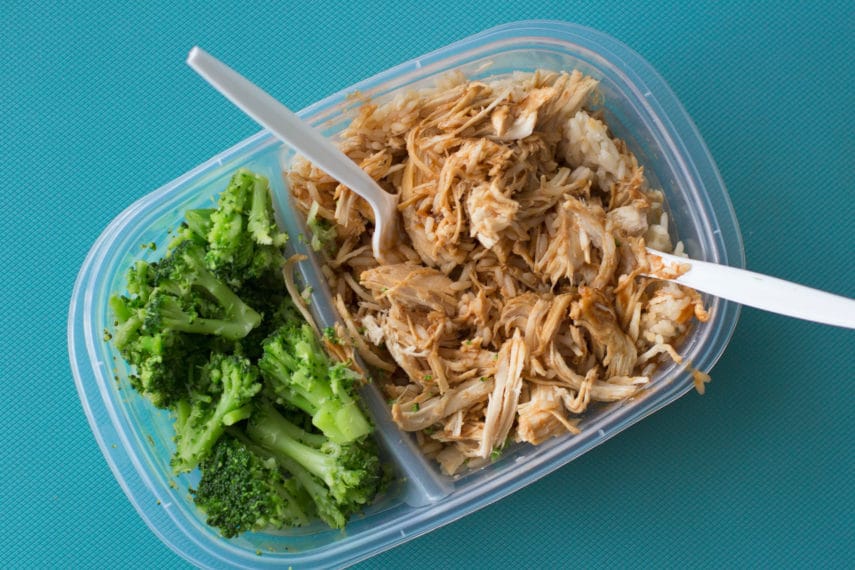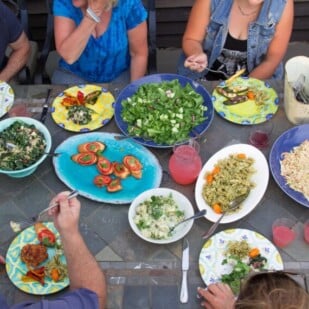Can I Follow The Low FODMAP Diet While Away at School?
If you’re away at school – or, you frequently eat at your office cafeteria, or another place where many food choices are hard to control – going on a low FODMAP diet for Irritable Bowel Syndrome (IBS) can be super challenging. Can it be done?
Yes. But there are extra precautions you’ll want to take to stay in the driver’s seat as much as possible.

Timing Is Everything
One of the first questions I pose to students who live on campus and are interested in trialing a low FODMAP plan is: Is there any other time you can do this? (This is after I ask them if they are working with a dietitian, because they should be!)
Don’t get me wrong – a low FODMAP diet can be a life-changer for people with Irritable Bowel Syndrome (IBS), and I encourage anyone with a diagnosis to give it a try. But it’s important to remember that the Elimination Phase of the low FODMAP plan is quite restrictive, and many of the foods that you’ll be avoiding during those 2 to 6 weeks are what you might call “invisible foods.”
Ingredients like garlic, onion, honey and others that you may not be able to see in prepared foods will throw off your Elimination Phase by provoking symptoms. Common cafeteria offerings like salad dressings, soups and many sauces will often contain these hidden high FODMAP ingredients.
Even the “plain” roasted chicken at the salad bar might have been marinated with garlic.

Use Your Breaks Wisely
When a client with IBS comes to me and says “the low FODMAP diet didn’t work for me,” my first instinct is to take a closer look at what they’ve been eating, and see if some of those invisible high FODMAP foods may be lurking in their diets.
Eating food prepared by someone else, particularly in a cafeteria setting, can make it nearly impossible to know for sure if you’re avoiding all of the foods you need to skip while on the Elimination Phase.
So first, here are some other times you can do a low FODMAP elimination: Winter Break (after the holidays are over). Break. Spring Break (if you’re not traveling, that is. Even if you’re only home for a week, at least that cuts back on the amount of time you’ll have to “go low” on campus).
Cafeteria Strategies
If you don’t expect to be in the comfort of a home kitchen any time soon but would really like some relief from your symptoms (75% of people with IBS do respond to a low FODMAP diet!), you can give a low FODMAP diet a try while eating in the cafeteria.
And you should take a look at The Low FODMAP Diet Gentle Plan as a possible alternative for managing your symptoms while in an environment you may have less control over.
Here are some strategies you can use to make a low FODMAP elimination on campus a success.

Eat Naked
No, not like that! But finding cafeteria foods in their most undressed states – think salad bar vegetables (but not prepared salads like 3-bean salad (high FODMAP) or tuna salad, which could have onion added), hard-boiled eggs, fresh fruit, cheese sticks – ensures you are aware of every ingredient you are eating, and can make sure they all meet the requirements of your low FODMAP elimination. Make sure you have the Monash University Low FODMAP Diet App.
It is an indispensible guide to all things low FODMAP!
Supplement From Home
Chances are your cafeteria doesn’t have any low FODMAP gluten-free crackers, or maybe high FODMAP nuts like cashews are the only ones on the salad bar. Toss a box of low FODMAP gluten-free crackers in your backpack or a small bag of low FODMAP walnuts so you have more safe ingredients to work with.
Make your own low FODMAP safe snack mix like this one.
Hack The Caf
A little creativity goes a long way. Take those naked ingredients from the dining hall and that you’ve brought yourself and have a little culinary fun. Chop up 2 hard-boiled eggs, mix in some mayo, scoop it up with some of your crackers and the salad bar’s carrot sticks.
Voila, your naked ingredients have become a meal. Check out this egg salad snack idea.
Seek Out An Expert
Many campuses have a registered dietitian nutritionist (RDN) on staff. Make an appointment with this food pro; even if you’re working with an RDN off campus, the school’s dietitian can help you navigate the cafeteria (they may even have more information than is available to you on what’s actually in some of the food served).
If there’s no RDN at your disposal, ask to speak with the foodservice director or chef; that person may be able to share ingredient lists so you can do your own detective work. Looking for a low FODMAP savvy RDN? Check out our listing on our Resource Page.
Find Some Go-Tos
You don’t need to reinvent the wheel every day, especially since the Elimination Phase of the low FODMAP diet need not last longer than 6 weeks. Find a couple of options that satisfy you for each meal, and rotate through them throughout the week.
The simpler you keep things, the less likely you are to make a wrong move.
Stock Your Dorm
Late-night ice cream or wings are not going to cut it while you’re on a low FODMAP elimination. Keeping low FODMAP foods at the ready in your room will help you stick with it for the 2 to 6 weeks that you need to commit for. Low FODMAP granola bars (like FODY), popcorn (like original SkinnyPop), lactose-free yogurts (like Green Valley Organics), low FODMAP crackers (like Mary’s Gone Crackers), Green Light seeds (like pumpkin seeds) and single-serving mini dark chocolate bars can help fuel those study sessions and keep your gut happy.
Our articles on How To Choose Low FODMAP Protein Bars, Snack Bars & Energy Bars, and All About Low FODMAP Meal Replacements, Protein Powders & Protein Shakes have loads of info for you.
Some other articles that may help you succeed following the low FODMAP diet while eating away from home:
- How To Make The Low FODMAP Diet Elimination Phase Easier To Follow
- Five Easy Steps To Change Any Habit
- Top 10 Strategies for Eating Out on the Low FODMAP Diet
- Drinking Alcohol On the Low FODMAP Diet
- Best Low FODMAP Snacks For On the Run
Have any other strategies you can share? Let us know in the comments below!







